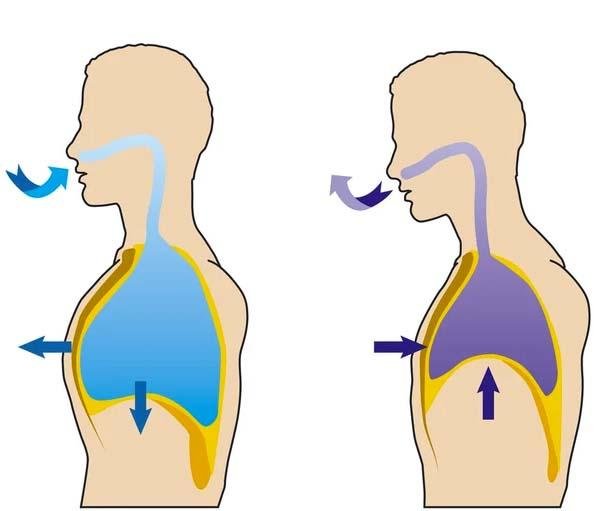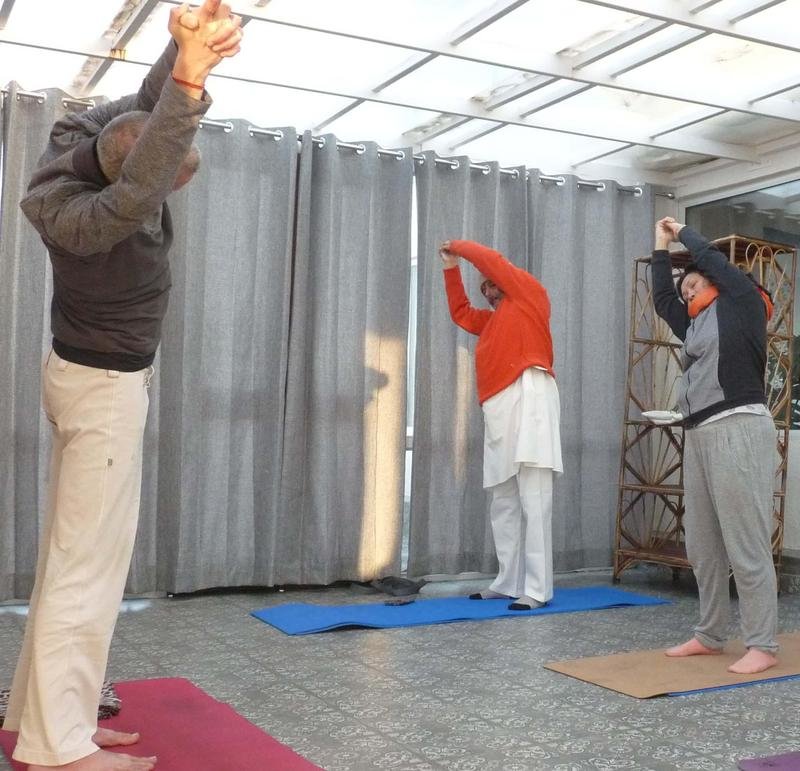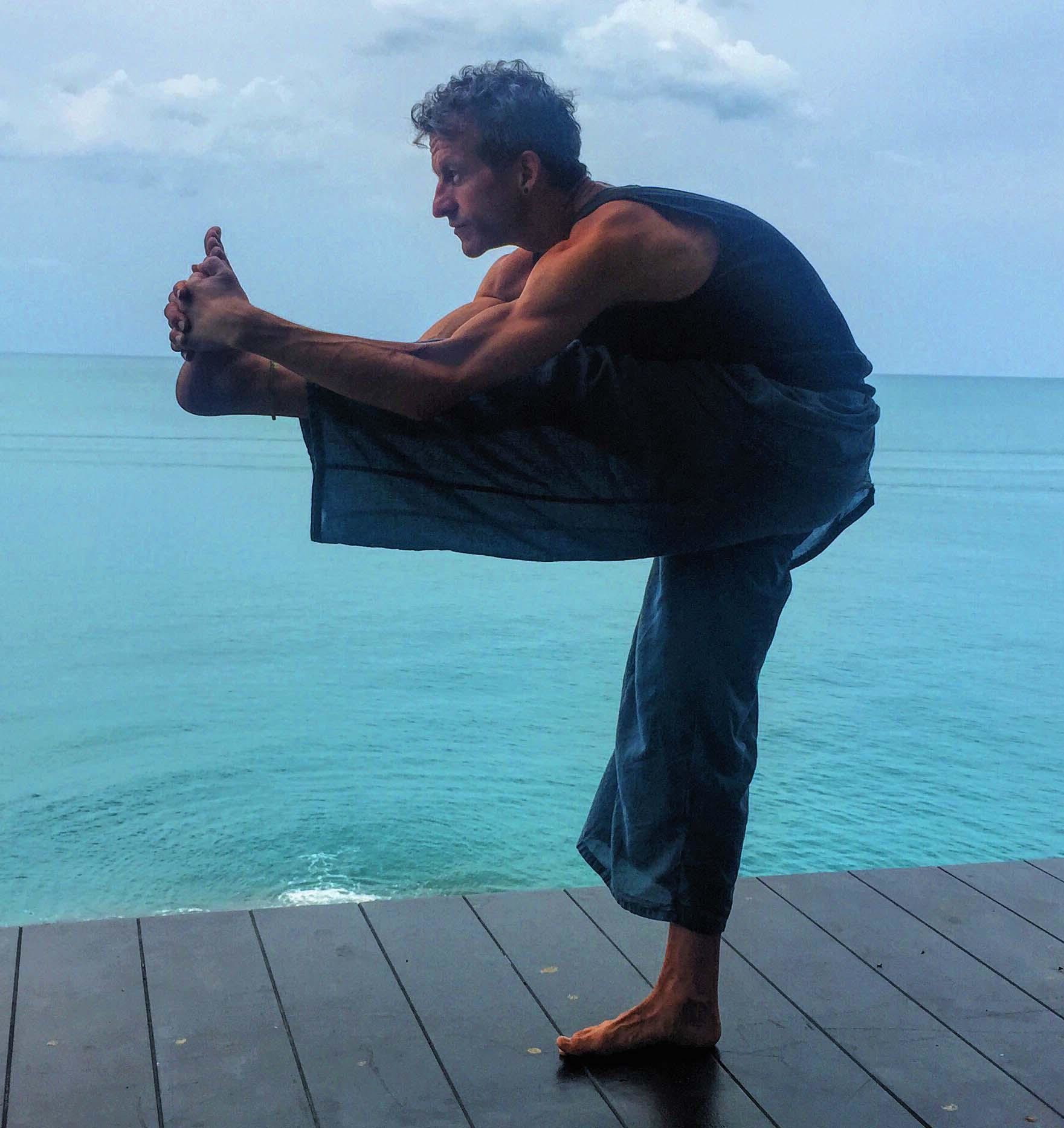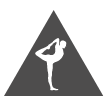[Brian]Why Practice Breath Awareness? 〜なぜ呼吸への気づきを練習するのでしょうか?〜

ある有名なインドのグルは、次のように述べています。
「あなたが生きている限り、それは常にそこにあります。 それはあなたの心を集中させるために、最も安定した信頼できるものです。」
呼吸は、私たちにとって当たり前のことであり、普段の生活の中でめったに意識することがありません。 ヨガ、太極拳、気功、その他の古代芸術などでは、呼吸に重点が置かれています。 注意深い呼吸は集中力を高めるのに役立つだけでなく、継続的な練習で心と体の意識を高めるのにも役立ちます。
なぜアーサナの練習中ですか?
ヨガでよく出てくる言葉は「プラナヤマ」です。これは基本的に「生命エネルギー」(プラナ=気)と「コントロール」(ヤマ=支配、制止、伸)を意味します。本質的に、プラナヤマは呼吸を制御されており、さまざまなエクササイズがあり、多くのヨガ教師はヨガレッスンの一部としてプラナヤマを取り入れています。アーサナの練習をしながら呼吸に集中することがなぜ重要なのか疑問に思ったことはありませんか?または、私たちの動きを呼吸と同期させることがどのように役立つでしょうか?
まず、呼吸は心と体を結びつけ、感情的および肉体的に感じる方法に大きな影響を与える可能性があります。それはあなたの体の生理学的プロセスにも不可欠です。それにもかかわらず、私たちは一般的に私たちの呼吸パターンや習慣を意識していません。おそらく呼吸は24時間毎日自動的に起こるものだからです。
アーサナの練習中に呼吸を意識することで、呼吸と体の自然なつながりを見つけることができます。心と呼吸と体のこの協調的な融合により、ヨガの練習の質が向上します。
生理学的には、呼吸プロセスに直接関与している3つの臓器、肺、横隔膜、腹筋を考えることができます。
あなたが今これを読んでいるので、それを試してみてください...。鼻から深呼吸してください。吸い込むと、胸が風船のように膨らみ、横隔膜が下に動き始め、胃が前に伸びるにつれて腹部が押し出されます。次に、息を吐くと横隔膜が弛緩してドーム型に戻り、腹部や肺も弛緩しているのを感じることができます。これを理解し、呼吸をアーサナの練習と同期させることで、身体とのつながりが深まり、練習がより効率的になります。
One famous Indian guru said, "Nothing and no one is as reliable as your breath.
As long as you live, it will always be there. It is the most steady and reliable thing to focus your mind on."
Breathing is something we generally take for granted and rarely consider as we go about our daily lives. In practices such as Yoga, Tai Chi, Qi Gong, and other ancient arts, there's a lot of emphasis on breath. Not only does mindful breathing help develop focus and concentration, it is also helpful in increasing awareness of the body and, with ongoing practice, the mind.
Why during asana practice?
One word that comes up a lot in yoga is "pranayama", which basically means "life energy" (prana = 気) and "control" (yama = 制御, 制止, 延長). In essence, pranayama is controlled breathing and there are numerous different exercises and many yoga teachers include pranayama as a part of their yoga lessons. Have you ever wondered why it is important to focus on breathing while doing asana practice? Or how it could be quite helpful to synchronize our movements with the breath?
To start, breathing unites the body & mind together and can greatly affect the way you feel emotionally & physically. It is also essential for your body's physiological processes. Nevertheless, we are generally not conscious of our breathing patterns and habits. Perhaps because breathing is something that happens automatically, 24 hours a day, every day.
Breathing awareness during asana practice pushes us to find the natural connection between breath and body. The quality of yoga practice increases with this coordinated fusion of mind, breath, and body.
Physiologically, we can consider three organs directly involved in the breathing process: the lungs, the diaphragm, and the abdominal muscles.
As you are reading this now, try it.... Take a deep breath in through your nose. When inhaling, you can feel the chest expanding like a balloon and your diaphragm starts to move downwards, which pushes the abdomen as your stomach expands forwards. Next, as you exhale, the diaphragm relaxes and goes back to its domed shape and you can also feel the abdomen and lungs relaxing. Understanding this and synchronizing the breath with asana practice deepens your connection with the physical body which makes your practice more efficient.

あなたの快適なゾーン
アーサナを練習するとき、呼吸の質は動き、ストレッチ、姿勢、そして練習全体に影響を与えます。呼吸と練習を調整することは、バランス、安定性、気づき、さらには快適さを生み出すのに大いに役立ちます。ここで非常に重要な点の1つは、一人一人の呼吸能力が異なることです。そのため、私たちは注意を払い、自分自身の呼吸の質をチェックする必要があります。ヨガの練習に関連して呼吸を理解することで、私たちは自分の限界、能力、そして快適なゾーンをよりよく知ることができます。
もう少し練習してみましょう。あなたはこれを立ったり椅子に座ったりすることができます。背骨を上向きにまっすぐにできることを確認してください。深く吸い込むと同時に、腕をまっすぐ持ち上げます。息を吐き、形を保ちます。もう一度息を吸い込み、腕(および背骨)を少し高く伸ばします。そして次の息を吐きながら、上半身全体と腕を左に曲げます。ここにとどまり、もう一度吸い込んで、背骨を少し左に伸ばすことができるかどうかを確認してください。別の息を吐きながら、もう少し曲がることができるかどうかを確認します。最後に、吸い込んで、ゆっくりと中央に戻ります。一度息を吐きます。腕をまっすぐ伸ばして、もう一度吸い込みます。そして次の息を吐きながら、体と腕を右側に曲げます。ここにとどまり、少し深く横に伸びて吸い込みます。息を吐き、少し深く曲げます。最後に、息を吸いながらゆっくりと戻ってきます。リラックス。
左または右に曲がったときに、自分が限界に達していると感じましたか?可動域についてどのように認識しましたか?呼吸を動きや姿勢に合わせることで、動きの範囲を調べ、快適な領域である「快適ゾーン」を見つけることができました。ヨガを練習するとき、私たちは自分の快適ゾーンを超えて自分自身を急いで押してはいけないので、これは重要です。呼吸を落ち着かせて安定させ、呼吸を追うことで、快適ゾーンの境界を理解することができます。時間と練習を重ねることで、快適ゾーンをゆっくりと拡大し、ポーズの奥深く、練習の奥深くまで進むことができます。
Your Comfort Zone
When you practice asana, quality of breath influences each movement, each stretch, each posture, and the entire practice. Coordinating your breathing with your practice greatly helps to create balance, stability, awareness, and even comfort. One very important point here is that breath capacity for each person is different, so we need to be mindful and check the quality of our own individual breathing. By understanding the breath in relation to the yoga practice, we can become much more aware of our limitations, our abilities, and our comfort zones.
Let's try another little exercise. You can do this standing or sitting on a chair. Be sure you can straighten your spine upwards. Inhale deeply and at the same time lift your arms straight up. Exhale and keep the shape. Inhale again and maybe reach your arms (and spine) up a little bit higher. And with the next exhale, bend your whole upper body and arms over to the left. Stay here and inhale again, see if you can lengthen your spine a little towards the left. With another exhale, see if you can bend a little further. Finally, inhaling, slowly come back up to the center. Exhale once. Inhale again, reaching your arms straight up. And with the next exhale, bend your body and arms toward the right side. Stay here and inhale, extending to the side a little deeper. Exhale, bending a little deeper. Finally, slowly come back up as you inhale. Relax.
Did you feel yourself reaching your limit as you bent over to the left or to the right? What was your awareness regarding your range of motion? By coordinating your breath with the movement and posture, you were able to explore your range of movement and hopefully find your area of comfort, your "comfort zone". This is important because we should not rush to push ourselves beyond our comfort zones when practicing yoga. By keeping the breath calm and steady, and by following the breath, we can understand the boundaries of our comfort zones. With time and practice we can also begin to slowly enlarge the comfort zone and go deeper into the poses, deeper into the practice.

心理的メリット
グーグルで「呼吸の心理的メリット」を検索すると、呼吸と心の関係について論じている記事がたくさん見つかるでしょう。これは、多くの興味深い発見を伴う刺激的で成長している研究分野です。広く認識されている研究の1つは、各呼吸を数えることで、参加者が脳の特定の領域に影響を与えることができることを示しました。数えることで、彼らは特に呼吸に集中し、正確に数えた人は、特に感情、記憶、意識に関連する領域で、通常よりも高い脳活動を示しました。 「ボックス呼吸」(サンスクリット語の名前:Sama Vritti)と呼ばれる1つのプラナヤマ運動は、副交感神経系を活性化します。簡単に言えば、これは、注意力と集中力が向上する一方で、不安と落ち着きのなさが軽減されることを意味します。
最後の簡単な演習として、「ボックス呼吸」を行いましょう。好きな場所に快適に座りますが、まっすぐ後ろを向いていることを確認してください。呼吸に注意してください。 2、3回、リラックスした息を吐きながら深く吸い込みます。 「1、2、3、4」をゆっくりと数えながら、もう一度吸い込みます。息を止めて、もう一度「!、2、3、4」を数えます。再び「4」までゆっくりと数えて息を吐きます。そしてもう一度「1、2、3、4」を数えて息を止めます。これを1~2分間繰り返します。それでおしまい。おそらくあなたは少し違った、よりリラックスした、より集中していると感じます。研究によると、これを1回だけ実践しても、目立った効果が得られないことがよくあります。しかし、「ボックス呼吸」(または他のプラナヤマのエクササイズ)を長期間にわたって毎日練習すると、明らかな利点が現れ始めます。
Psychological Benefits
If you go to Google and search "psychological benefits of breathing", you will likely find many articles discussing the relationship between breath and mind. This has been an exciting and growing area of study with many interesting discoveries. One widely recognized study showed that by counting each breath, participants were able to influence certain areas of the brain. Counting made them particularly focused on their breathing and those who counted accurately had higher brain activity than usual, especially in regions related to emotion, memory, and awareness. One pranayama exercise, called "box-breathing" (Sanskrit name: Sama Vritti), activates the parasympathetic nervous system. Simply, this means that anxiety and restlessness are reduced while attention-span and concentration improve.
Let's do some "box-breathing" as one last simple exercise. Sit comfortably anywhere you like, but make sure you can keep a straight back. Become mindful of your breath. Two or three times, Inhale deeply with relaxing exhales. Now inhale again, slowly counting "1, 2, 3, 4,". Hold the breath and again count "!, 2, 3, 4". Exhale slowly counting up to "4" again. And once again hold the breath counting "1, 2, 3, 4". Repeat this for one or two minutes. That's it. Maybe you feel a bit different, more relaxed, maybe more focused. Studies have generally shown that practicing this only one time doesn't often have noticeable effects. However, practising "box-breathing" (or other pranayama exercises) starts to show clear benefits when practiced daily over a longer period of time.

結論は
ですから、ヨガの練習中に私たちの呼吸パターンを覚えておくことが重要である理由はたくさんあります。 また、これをヨガマットから取り除き、呼吸の認識を利用して日常生活に役立てることもできます。 電車の中で、コンピュータで、公の場で話すとき、ほとんどの状況は、息を気にするために一時停止することで恩恵を受けることができます。 それは私達が私達のヨガの練習と一般的な生活の中でバランスと接続性を見つけるのを助けます。
In Conclusion
So, there are many reasons why it is important to keep in mind our breathing patterns during yoga practice. We can also take this away from the yoga mat and use breath awareness to benefit our daily lives. While on a train, at your computer, speaking in public, most any situation can benefit from pausing to become mindful of the breath. It helps us to find balance and connectivity in our yoga practice and life in general.
one breath at a time.
the breath
it cycles
one cannot
inhale and exhale at the same time
the moon
does it shrink and grow
at the same time?
the ocean's tides
ebb follows flow
flow follows ebb
the lungs expand
the lungs contract
perhaps sometimes
it can feel infinite
この記事を書いた人
Brian
タイのビカサヨガリトリート2016年にRYT500を取得後に。北インドのリシケシヨガシュラムでの生活を経て2019年夏に京都に移住。
アーサナシーケンス、ヴィンヤサ、解剖学、ダイエット、ユニバーサルヨガやインヨガなどのスタイルに焦点を当てた多様性のあるヨガの知識を有し、呼吸に重点が置いたマインドフルネスへの指導を大切にしている。
Welcome to our studio新規メンバー募集中






 Cafe
Cafe TriYoga
TriYoga





